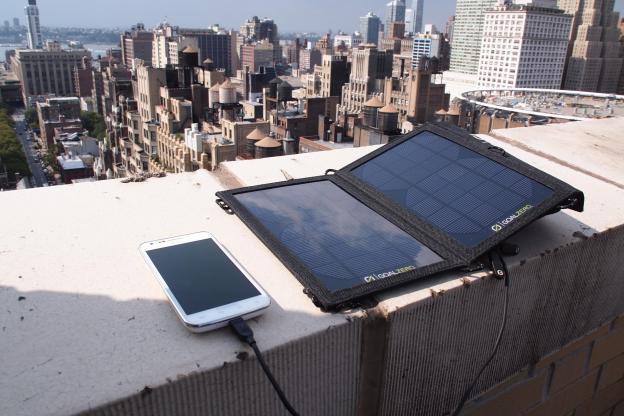
Kermit once told us it’s not easy being green. Hey, it is if you’ve got a few hundred bucks to spare. When I was approached by Goal Zero about its Guide 10 Plus Adventure Solar Charger kit, I was immediately intrigued. The Digital Trends New York office sits on the top floor, with plenty of sunshine to spare. This could be a fun and experimental way of harvesting energy to charge little gadgets and devices, such as my cellphone or iPod while I’m wrapping up work. That is, if the product worked. But did it?
Look and feel
Let’s get down to the basics first: the Goal Zero Guide 10 Plus Adventure Solar Charger is made to be extremely portable. The tiny folder opens up to two solar panels complete with a netted zipper pocket in the back which contains the 12V Guide 10 USB station. The set also comes with a cigarette lighter adapter should you want to leave your gadgets charging with the charger sitting on your dashboard. The entire kit is water resistant but not waterproof, which is good enough for a casual user like myself. Those who plan to hike and stay overnight in the outdoors with these might want to consider other options.

Goal Zero Guide 10 Plus Solar Charger is also pretty lightweight. You can pack it along any trip for a boost of power. The device is compatible with gadgets that charge with a USB cord, and it comes with a separate battery charger device to juice up to four AA batteries. All four batteries have to be in the socket at the same time, though not all have to be empty for the charger to get running.
Let there be light…?
As mentioned, a casual user like myself would probably only use a solar charger just for a quick boost of juice if my surge protector ran out of slots. Being green is a type of behavior I should get into more frequently to be more energy efficient. For my experiment, I attempted to charge my Samsung Galaxy S2 which was standing at 70 percent before the charge. I left these outdoors in clear direction of sunlight. The instructions say it would be able to fully charge a smartphone anywhere between two to four hours, so I decided to check back in 30 minutes to see the difference.

Frustrated but not willing to give up, I tried again the next morning. This time, I laid the Guide 10 Adventure Solar Charger in front of a window receiving lots of sun. In 20 minutes, surely enough my Galaxy S2 went from 88 to 100 percent! Unfortunately, when I tried the same with a Samsung Galaxy S3 and Motorola Photon Q, both refuse to take charge despite them both saying they were charging, and each lost about 5 to 6 percent of battery in a 35 minute span. Ouch.
I tried changing locations, from in front of the window to a ledge directly under the sun to pasting the charger directly on the window like a sticker. None of the arrangements worked out. At one point, I kept hearing my phone go buzzing and stopping, indicating that it is receiving and un-receiving charge every other second. I didn’t understand. There seemed to be constant sunlight, but none of it registered. Perhaps the output from this 12V hardware isn’t enough to get the phones going.
Conclusion
I don’t want to fully blame the Guide 10 Plus Solar Charger because perhaps New York City sunlight simply wasn’t strong enough for the device. After all, the item seems to have been developed for the outdoorsy folks. Perhaps the charger will work well on top of a parked car while you’re camping or hung over a large rock when you take a break on a mountain hike. In a city environment, this weather was not its best friend.

In conclusion, I wouldn’t leave my cords at home just yet in place of the Guide 10 Adventure. If you have a hundred bucks and change to spare a test, hopefully this works put better for you than it did for my situation. I’d recommend strapping the charger to your backpack and take around for a walk or a bike to get a few percentage here and there, but this item is definitely not made for at-home use unless you live in the desert.
The Goal Zero Guide 10 Plus Adventure Solar Charger is available now for $160.
Editors' Recommendations
- The best solar chargers for your phone or tablet
- On the fence about buying solar panels? Tesla now offers them for rent


